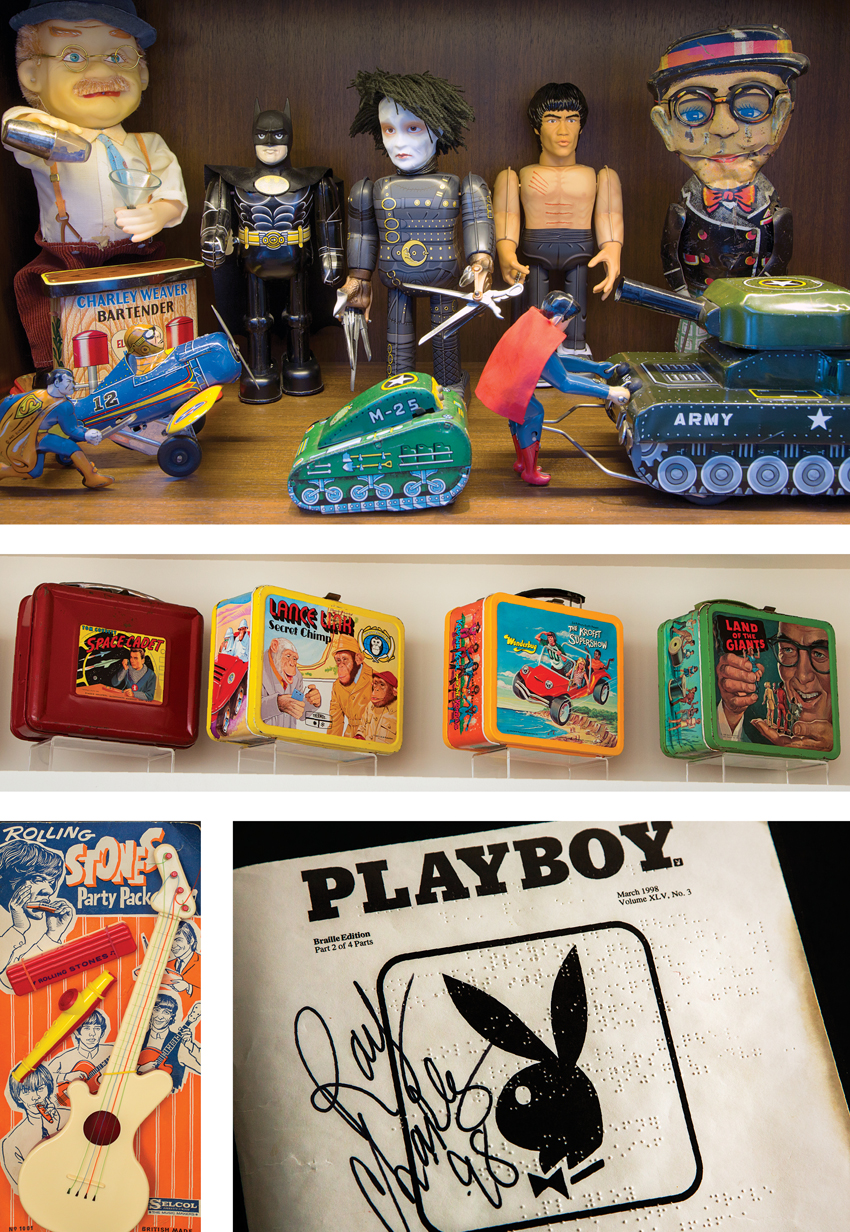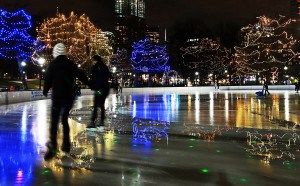Life Among Friends

Photographs by Eric Roth
Boston’s skyline has changed dramatically over the past decade, and one of its shining new icons is the Residences at W Boston in the Theater District. Designed by William Rawn Associates, the building is wrapped head to toe in glass, and its boatlike profile—complete with a prow jutting out toward the corner of Stuart and Tremont streets—affords sweeping views of the city. The top unit at the bow of this particular ship is one of the most coveted addresses in town.
It’s the one Kevin Bright and his wife, Claudia, had their eyes on from the start. In 2007, the Emmy Award–winning executive producer of the TV show Friends was renting a unit across the street, in One Charles—it was his crash pad while he was in town teaching at Emerson College, his alma mater—when construction started on the W.
“We watched the building go up from scratch,” Bright said from the couch in his penthouse unit that faces both the Charles River and Boston Harbor. “As it took shape, I looked across to this apartment and said, ‘Ooh, it’s got a view of the river, a view of the Common, and it’s facing the other way, too. That’s the apartment I need to be in.’” Once the building was enclosed in glass, the Brights took the elevator up to admire the view, and fell in love with the unit’s unusual footprint. “Others might have been put off because it’s not rectangular, but I had a few ideas about what I could do with the space,” Bright said.
At the time, his Friends spinoff series, Joey, had ended, and he was “in search of chapter two” of his life. The couple’s younger son was an undergrad at Boston College, and Bright was serving on the board of Emerson College as well as teaching. Though it was a dramatic departure from their life in L.A., moving to Boston seemed right. “In Los Angeles, you can’t walk to the Staples Center or Dodgers Stadium,” Bright said. “When we’re here, we eat, we walk a lot. We don’t really get in our cars. To me, that’s the really amazing part. We’ve adopted the Celtics since we started living here.”
Finding someone to work on the layout and interior finishes of the challenging 2,600-square-foot unit was easy: The Boston-based interior designer Meichi Peng had done a demo condominium for the W, and Bright liked her work. “We connected immediately,” he said. “Her charge was to have this mixture of old and new, to make it feel seamless.”
Although the Brights didn’t come with furniture of their own, they did come loaded with art and quirky collectibles, including photographs by Man Ray, more than a dozen vintage metal lunch boxes, tin wind-up toys, and stacks of vinyl records. One of Bright’s most coveted pieces of ephemera is a braille edition of Playboy signed by Ray Charles. It’s framed and hanging above his desk in the office. And then there’s the massive bodhisattva statue.
Bright’s vintage collections reveal someone deeply in love with analog. Just ask him about LPs: “You pay the same amount of money, but when you download, you own nothing. You can’t sell it, you can’t put it in your hands and enjoy it, you can’t read the liner notes from it. There’s just more to the music than just hearing it,” he said. “There is just something about the nostalgia and warmth of picking up this piece of petroleum product and holding it in your hands. I’m still amazed that from that needle and that plastic you get that music in full fidelity.”
Entertainment is the family business. Bright’s father started his career as a vaudeville performer and eventually became a personal manager, but it took his son a while to realize his calling. Bright entered college in New York as a history of philosophy major, but soon enough began studying film. “I was always interested—borderline obsessed—with television, especially variety shows, and I thought, Okay, this is one of those classes where you just watch movies. Then it just kind of connected in that moment.” He transferred to Emerson in his junior year, drawn to Boston by faculty members like Dan Lounsbery—the famed producer of the Bell Telephone Hour, a highbrow music variety show that ran on NBC from 1959 through 1968—and then headed to California in the late ’70s.
Since the first episode of Friends in 1994, the television industry has gone through a major transformation. “The whole thing is turned upside down,” Bright said. “Now everyone from Amazon to Netflix to Verizon wants to be in the business, so the sources for original product are just multiplying. Why does HBO make a show like Boardwalk Empire? It costs a couple of million an episode—they’re definitely losing money on it. It’s all about subscribers and the various shows exclusive to that provider.”
“You can make a new series like Vegas that costs a couple a million an episode, or you can watch Honey Boo Boo, which costs probably about $35,000 an episode, and which one is getting the numbers now?”
In part, it was these major transformations in the medium that drew Bright back to his alma mater. Television may be more exciting than ever, but Bright and his colleagues still find that film-school graduates lack real-world skills. “The education process is not in sync with the actual profession,” he said. In an effort to change that, Bright regularly brings showbiz pros into the classroom. On any given day, he might Skype with the Emmy Award–winning lighting director Robert Dickinson, or the director Glenn Weiss, or the myriad others who’ve worked in Hollywood for years and have shelves full of awards to prove it.
And now Bright will have the opportunity to bring his students to his friends. In May, he was designated the senior executive director and founding director of Emerson College’s new Los Angeles Center, which is currently under construction on Hollywood’s Sunset Boulevard and slated to open in January. Although he and Claudia will be bicoastal once again, they’ll always have a place to enjoy the snow in style. “We moved in here in January 2011, and it was so great because within a day, it looked like a giant snow globe,” Claudia said. “Every day we look out the window and go, ‘Wow, look at how beautiful the sky is, look at the light on the river.’ I mean, every day is just so spectacular.”

Varenna cabinetry from Showroom and Blue de Savoie marble countertops add to the clean look in the kitchen. Poltrona Frau “Alo” stools from Montage give the space a pop of color.

Clockwise from top: The hallway features an original painting by Joni Mitchell, a vintage French television poster, and a lenticular photograph of the Beatles’ Abbey Road album cover; the Brights’ impressive art collection also includes a copy of Man Ray’s Le Violon d’Ingres and one of his rayographs, created by placing objects directly onto light-sensitive paper; to create the elegant foyer, interior designer Meichi Peng brought in pieces with lots of shimmer and shine, including a silk-and-linen rug from Steven King, a cast-aluminum vintage console, and a polished-nickel Dana John hooded mirror, purchased in L.A.

The corner of the unit is one of Boston’s most exciting spots to watch the sun set—when needed, a hidden TV pops out of the ceiling in front of the Meichi Peng–designed custom corner bench.

Clockwise from top: Vintage tin wind-up toys and action figures become high art; a sampling of the metal lunch boxes on display throughout the unit; Ray Charles autographed this Braille edition of Playboy; a vintage “Rolling Stones Party Pack.”
Want more? Check out additional photos of Kevin Bright’s W penthouse.


